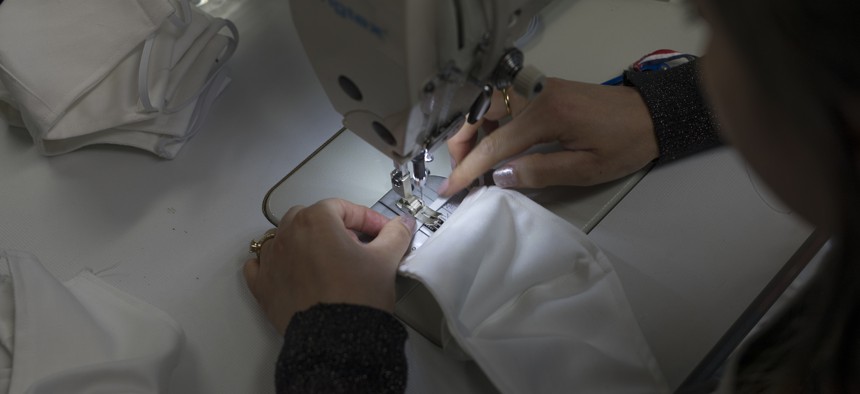‘We’re Doing What We Can’: How a Makeshift Network Is Filling in the Gaps with Medical Supplies

Across the country, people are hand-sewing surgical masks and 3D-printing face shields. AP Photo/Daniel Cole
A shortage of necessary medical supplies like face masks has engaged a broad coalition of helpers, from those at home with just a sewing machine and fabric to public libraries with 3D printers.
In nearly every corner of the country, nurses and doctors are reporting critical shortages of the very basic equipment they need to protect them from Covid-19: masks, gloves, and face shields.
Calls for help from medical professionals, spread widely on social media, have been met with a staggering number of people asking what they can do—and now, the task is to get them organized. The end product? A makeshift network of makerspaces, production studios, and ordinary people with sewing machines and 3D printers in their garages.
The handmade alternatives to personal protective equipment, or PPE, this network produces aren’t a substitute for commercially made medical gear, like N95 respirator masks. But in an emergency situation, dealing with a highly contagious respiratory illness like Covid-19, they can still help.
“I’m grateful for the overwhelming response,” said Dr. Shuhan He, an emergency physician at Massachusetts General Hospital. “For me, this is a life and death scenario.”
When the pleas for medical supplies first began, many on social media turned to a place that likely has a 3D printer or makerspace sitting idle: the local library. For items like plastic face shields, which can’t be easily made by those at home who are limited by what a sewing machine can produce, libraries seem the perfect fit. Libraries in New York have partnered with local universities to produce the plastic bands for face shields, while others donated their 3D printers to local hospitals. Just north of New York City, the White Plains Public Library brought their printer to St. John's Riverside Hospital in Yonkers, where one doctor is creating a “3D printing farm” to produce face shields and respirator masks for emergency workers and hospital staff.
Libraries in public schools and universities from Tennessee to Utah have also been put to work making face shields and masks. Alberta Comer, dean of libraries at the University of Utah, said that “when we first started building our 3-D printing program back in 2013, we had no idea … we would one day play a role that would touch so many lives.”
But other libraries say they haven’t been able to utilize their equipment. A representative from Seattle’s King County Library System said that their staff doesn’t have access to makerspaces due to a system-wide shutdown. A representative from the Boston Public Library said that their printers are made for much smaller projects and lack the components necessary to do any sort of major industrial production.
Other efforts have tried to engage a broader range of potential makers. On Facebook, a group called Open Source Covid-19 Medical Supplies claims over 53,000 members, a number that has grown each day since it started on March 10. Like most of these impromptu organization efforts, it’s shape adapts daily to what medical personnel need and what group members can contribute, said Gui Cavalcanti, the group’s founder. “Our fundamental thesis is that we have a global supply failure, and the problem of getting medical supplies will get worse before it gets better,” Cavalcanti said. “The goal of the group is to catalogue as many open source designs for the medical space spectrum and share them as widely as possible.”
The group has over 260 people organizing in a “volunteer NGO” structure, with members ranging from corporate executives, librarians, documentarians, and representatives from fabrication networks. The documents the group has collected also reflect that range—they have an 80-page, layman-accessible medical supply guide, references for home makers working from their garage, FDA-approved plans for injection moulding to laser cut face shields, and resources for professional manufacturing setups to retool their systems for medical supplies. On a Slack channel, 30 doctors are reviewing open source designs to ensure they meet certain standards.
Cavalcanti said they will be standing up a website soon that will be translated into most major languages so that they can become a “super robust and easy to use worldwide catalogue of designs.” In the meantime, they’re working with groups like Get Us PPE, a team of medical professionals connecting hospitals and health systems to people nearby with both homemade and commercially produced surgical masks, N95 respirators, goggles, gloves, and face shields. “We have to localize people together,” Cavalcanti said. “The longer a chain you make, the worse it will get.”
Get Us PPE, which was founded nine days after Cavalcanti’s group, is acting as a centralized location for hospitals and local health systems to signal their specific needs. Its medical team is run by Dr. He from MassGen, who said his colleagues organized to help the situation they’re seeing on the frontlines of the pandemic response. But while PPE donations have been useful, He is wary of people making more complex medical supplies in their garage. “I don’t want to see open-source 3D-printed ventilators,” he said. “We’re in talks with high-level authorities for that stuff. GM can fill in on that. The bigger need is PPE.”
Some online tutorials on PPE warn that people shouldn’t be making them for use by medical personnel. Craft stores and private makerspaces across the country have published guides on how to sew things like surgical masks, which only require fabric and elastic. One such store, Firefly Fiber Arts Studio in Chicago put up a video this week detailing a relatively easy process for creating cloth masks using a sewing machine, but Sarah Jamison, the store’s owner, said that she included a disclaimer for those who make them. “We are aware that the CDC does not recommend face masks to reduce the risk of catching COVID-19, and these masks do not replace medical masks used by medical staff,” she said. “Instead we see them as a way to alleviate anxiety in the public, and to help reduce the frequency of the wearer from touching their mouth and nose.”
Cavalcanti said that cloth masks still might be useful for medical personnel, but not as a replacement for the more secure N95 respirators. “Cloth masks could be used to cover existing N95 masks if doctors end up reusing them,” he said. Hand-sewn masks might not be accepted in some hospitals, though, which He said is due to the fact that they carry 13 times the risk of infections compared to medical-grade PPE. But these handmade materials could still be used for cancer patients and those who are immunocompromised, and He said that if hospitals have no more N95 respirators to spare, “it’s better than nothing.”
Other groups in the organizing effort are focusing not on making, but on connecting people and organizations with stockpiles of PPE to hospitals that need them so that healthcare workers can get supplies as quickly as possible. Andrew Stroup, a founding member of Project N95, a “medical equipment clearinghouse” that matches those with supplies to those with demand, said that his group grew out of a network of people from the current and former White House administrations, state and local government, and civic technology leadership. The government-heavy group is taking it “minute by minute,” he said. “We can’t wait three to five months for a manufacturing facility to ramp up and get N95-certified. Medical professionals need help now. We’re doing what we can.”
Healthcare workers say they are grateful that so many people have stepped up to help in different ways. “This is gonna be a long battle with Covid-19,” He said. “As a doctor, this is incredible to witness. I don’t know what the long term solution is, but this is an exciting short term solution.”
OTHER STORIES on Route Fifty:
-
Some States Stall Plastic Bag Bans During Coronavirus Outbreak
-
Nearly 200 Cities Short on Supplies for Dealing With Coronavirus, Mayors Report
-
Trump Signs Coronavirus Aid Package—But Democrats Say More Help Needed for States and Cities
-
$60 for Toilet Paper? How Attorneys General Are Fighting Price Gougers

NEXT STORY: One Governor’s Actions Highlight the Strengths—and Shortcomings—of State-Led Interventions






